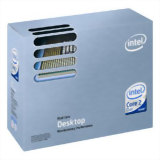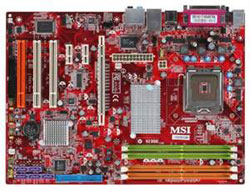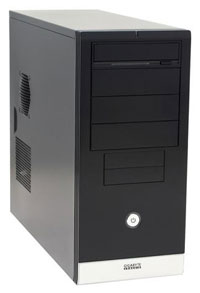Baseline Intel Midrange Platform
As we mentioned already, Intel has without a doubt regained the performance crown when it comes to CPUs. For pure number crunching, 3D rendering, video encoding, and other CPU intensive tasks, Intel's Core 2 Duo processors almost invariably outperform AMD's Athlon X2 offerings. They do cost a bit more, but they also run cooler and overclock better. All other things being equal, we currently recommend Intel configurations over AMD configurations, although there are a few advantages the AMD platform still holds. Most of our components remain the same as the previous page, with the exception of the motherboard and processor.
 |
Again, we feel there is little reason to consider anything other than a dual core processor these days. For Intel platforms, you really don't get much choice unless you want to go with an old Pentium 4 processor, as the single core versions of the Core 2 architecture won't be released for several more months. As with the AMD system, we selected the lowest end processor for our baseline configuration. The Core 2 Duo E6300 comes clocked at 1.86 GHz and features 2MB of shared L2 cache. Overclocking attempts with the E6300 have been extremely successful, and the limiting factor is almost always the motherboard and/or memory unless you spend money on higher end components. The default 7X CPU multiplier means that reaching a CPU clock speed of 3 GHz (something that is possible with most Core 2 Duo chips) will require a front side bus speed of 428 MHz, not to mention memory that can also run at DDR2-856 or higher. Unfortunately, motherboards that will support such bus speeds cost more money.
 |
Unlike the AMD platform, picking an ideal motherboard for socket 775 is a bit trickier. We could always go with one of the cheap ASRock motherboards that we have reviewed recently, but most of those are a bit quirky and none of them overclock very well. For a midrange system, we really don't want to skimp on the motherboard at all, and the most reasonable choice is to get a board that uses the P965 chipset. The MSI P965 Neo-F gets our recommendation, as it is currently the cheapest P965 motherboard available and it still performs reasonably well. It won't overclock as high as many of the other offerings on the market, but it is a very solid offering overall. The ECS P965 P965T-A and Foxconn P9657AA-8KS2H are similar in terms of stability, features, and overclocking support -- better in some areas, and worse in others. After our talk above about how high the E6300 can overclock, we need to make it absolutely clear that you'll never come near those overclock levels with any of the three motherboards we've just mentioned. Plan on flashing the BIOS as well, as the vast majority of P965 motherboards have had some serious memory compatibility issues with the initial BIOS revisions. Assuming you can live with those limitations, at $100 the board is still a reasonable option, but you do get what you pay for.
We've covered the memory and video card choices already, so let's move on to the storage and other options. The choice of DVD-RW drives is pretty simple: get whatever it is cheapest. Some of the DVD burners are more compatible with a wider range of media, but overall the NEC ND-3550A works very well and at $30 there's little reason to get anything else. If prices change in the near future, LG, BenQ, Pioneer, and LiteOn are reasonable alternatives.
Choosing a hard drive takes a bit more effort. Most of the major SATA drives are worth consideration, so it comes down to a matter of price and capacity, but warranty and noise levels also play a role. The Samsung 3.0Gbps 250GB SpinPoint P offers an extremely low price/GB and it is also the quietest hard drive presently available. It is not the fastest drive available, so if you do a lot of hard disk intensive tasks you might prefer something else, but 250GB of storage and a quiet drive to go with our silent GPU seems to make sense as a baseline recommendation. Western Digital, Seagate, Maxtor (who is now owned by Seagate), and Hitachi all offer varying features, prices, warranties, etc. If you are less concerned about noise levels, the Western Digital 250 GB SE16 is a close second place that only costs a couple dollars more.
 |
We won't worry too much about the keyboard and mouse other than to say get whatever you like best. Most of us like Microsoft and Logitech input devices, but if you have a personal preference stick with that. For the case, we wanted something that was reasonably easy to work with, reasonably quiet, and not too expensive. The Gigabyte GZ-X1 fits these requirements and it also includes a 350W power supply. The power supply may not be the best for extreme overclocking or running a high-end configuration, but the baseline selections that we've chosen will be hard-pressed to get over ~250W of total power draw. If you don't like the way the Gigabyte case looks, as with the keyboard feel free to get something that you do like. For the power supply, if you want something better than a bundled PSU, we would recommend looking at Fotron Source (FSP Group/Sparkle), Enermax, OCZ, and SeaSonic as quality upgrades, although most aftermarket PSUs that are substantially better than the bundled 350W PSU are likely to cost quite a bit of money.
We have covered all of the baseline components with the exception of the operating system and the display. We will save discussion of the LCD choices for a separate section. As for the operating system, Windows XP Media Center Edition 2005 falls somewhere between XP Home and XP Professional, both in terms of price and features. For home networks, we definitely prefer XP Professional over XP Home, but MCE 2005 includes most of the features we like and it only costs about $10 more than XP Home. In addition, users who add a TV tuner also get the MCE interface, which does a very good job at providing PVR functionality.













49 Comments
View All Comments
JarredWalton - Tuesday, September 26, 2006 - link
Caps are often one of the most critical factors in overclocking. Obviously, the difference isn't huge, and neither is the difference in price (about $20 more for the DS3). "A bit better" means that you will really have to be pushing hard to reach that point; RAM is likely to give out before either motherboard.RamarC - Tuesday, September 26, 2006 - link
IMHO, the upgraded Intel config can be improved quite a bit for $82 more ($37 more w/available rebates). I'd move up to an E6600, select ASUS P5B-E mobo, and use dual hard drives in matrixRAID. An Antec Sonata II w/450W PS would be subbed in for the case. This config will be plenty fast in 'stock' form and still has some OC headroom.Core2Duo E6600 . . . . . 319
ASUS P5B-E . . . . . . . 164
OCZ 2GB Gold Gamer DDR2-800 . 260
GeForce 7900GS
or Radeon x1900gt . . .. 206
2 WD 1600JS 160GB . . . . 124
LiteOn 165H6S retail . . . 42
Acer AL2216WBD 22" WS . . . 337
Antec Sonata II w/450W PS . 110
Logitech Premium . . . . 30
Windows XP MCE . . . . . 120
Total . . . . . . . . .. . $1,712
rjm55 - Tuesday, September 26, 2006 - link
I'm in total ageement with your idea. I was more than a little surprised to see the lowest 2MB cache Core 2 Duo as the choice in the first Intel, but I figured it would be fixed in the the upgrade choice with a 4MB cache model. It wasn't. The 4MB cache does make a performance diffence and is always faster at the same speed. I would pick a E6600 for my own midrange system.I would also choose a lowend 975 for the true dual x8 Crossfire. Abit has a decent 975 board for $159. This would actually be $5 less than your setup with a 965 board.
JarredWalton - Wednesday, September 27, 2006 - link
I added some clarification on the "upgraded" Core 2 page for you guys. :)Basically, your selections are perfectly acceptable alternatives, but if I were to put up my upgraded build with overclocking agains your upgraded builds, I would wager I can get better overall performance. Not everyone wants to overclock, and that's fine, but my picks were made with a bit more of an overclocking bias.
The $260 OCZ DDR2-800 doesn't OC very well at all, while the $280 RAM does much better. In fact, the $260 RAM you link has had some compatibility issues with some motherboards (it wants to POST with higher voltages for the listed timings, IIRC), so you would be better off getting the $220 OCZ DDR2-667 in my book.
The bottom line is that you have to determine what you want to do with the PC. For gaming (you mention CrossFire), spend a lot of money on the GPUs before you even worry about upgrading the CPU (unless you run games at 1024x768). If you plan on running X1900 CrossFire, though, you really better think about upgrading to a nice PSU like the Fotron Source listed. For X1900 XT CrossFire (or X1950 CF), you should probably go with a Fotron Source 700W (or OCZ GameXStream, Thermaltake 700W, or several others which are just rebranded FSP units).
JarredWalton - Tuesday, September 26, 2006 - link
I unfortunately have to say that Antec PSUs have gone way downhill in the past year. Ask Gary how many dead Antec units he has sitting around. Other than that, though, you demonstrate exactly what I tried to point out: there are a ton of different ways to attack a midrange build, especially at the $1500-$1700 price point. We went with better RAM and a much better PSU with a lower end CPU. RAID won't really help performance much IMO (unless you want RAID 1 for redundancy), and I would rather have a single drive instead of two drives for the same amount of storage (cheaper too).As for the CPU, the E6600 is definitely faster. With overclocking, it's lot closer, as the 2MB cache Core 2 Duos will generally overclock further than the 4MB cache CPUs. At that point, you have to decide whether you really need faster CPU performance or if you should improve something else. If you play games as your primary focus, even the X2 3800+ will be essentially tied with the E6600 until you start to get into much faster GPUs.
RamarC - Tuesday, September 26, 2006 - link
I'm a big fan of MatrixRaid. Dual 160s can be config'd as a 40gb mirror (boot, OS, important docs, etc.), and a 220gb strips set (game files, mp3s, dvd rips, page file, temp folder, etc.). A bit more expensive than a single drive, but a more performance and much safer.You guys obviously go through PSs more than me. Still, I'd rather spend about the same cash and get a faster stock system than one that I have to OC to reach the same level of performance.
Araemo - Tuesday, September 26, 2006 - link
I didn't see any discussion of it in the article, but which of those monitors are 24 bit(8 bit panels)?I'm rather picky about colors, and I wouldn't consider any 6 bit panels. I've seen 8 bit panels with good enough refresh times(Using overdrive) from some companies, but it can be such a PITA to find out for sure if a given monitor uses a panel that is 8 bit or 6 bit, that I would like to see that kind of information noted when a recommendation is being made...
Super Nade - Tuesday, September 26, 2006 - link
Hi,I have serious issues regarding the PSU's being recommended. Why are you guys skimping on a no-name, possibly dodgy PSU? To keep things in budget, I'd suggest cutting back on the case and the DRAM, possibly substituting a 17 inch display for the 19 inch. There are several good reasonably priced PSU's (say $80 range)available.
I like the article and agree with most of the recommendations, but for the PSU :)
Regards,
S-N
Revolutionary - Wednesday, September 27, 2006 - link
Everybody questioning the choice of a Fortron-Source PSU because they "have not heard of them" needs to get a clue.They MAKE power-supplies as an ODM. Often the Antec, Enermax, whatever-pricey-name-brand-you-want-to-insert PSU is just a re-badged FS model.
And if you check out the "cool-n-quiet" community, you will find that FSP actually has quite a following. I've personally used 3 of their PSUs (I'm still using one, actually: a 300W 120mm fan model that I bought about 3 years ago...).
Mass marketing brand awareness does not a good component make.
Gary Key - Tuesday, September 26, 2006 - link
While I am one to usually advocate buying a 700W or above power supply for any system ;-> , we looked at the baseline system requirements and determined the included power supply from Gigabyte was adequate to meet the systems needs. There are numerous case/power supply choices in this range and most of the tier one case suppliers provide decent power supplies. I for one like the Cooler Master Centurion 5 combo with their 380w power supply for a base system. Obviously, if you designed a system around the base configuration and wanted to overclock your system (in the case of the AMD unit, also run SLI) then a better power supply is certainly warranted.In the upgraded configuration I think our power supply choice reflected one of the best price/performance choices in the 500W~600W range. There was another FPS 550W power supply that was actually at the top of our list for a couple of more dollars but it was sold out at the majority of on-line stores.
:)